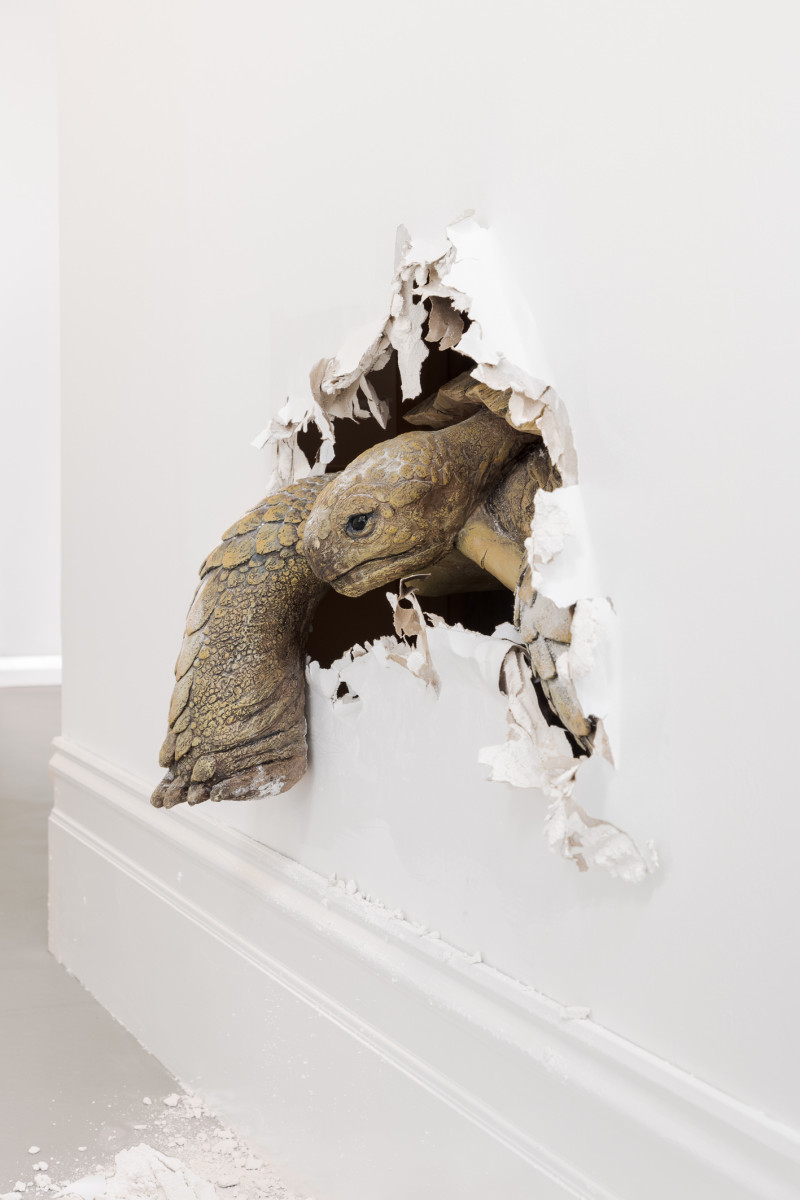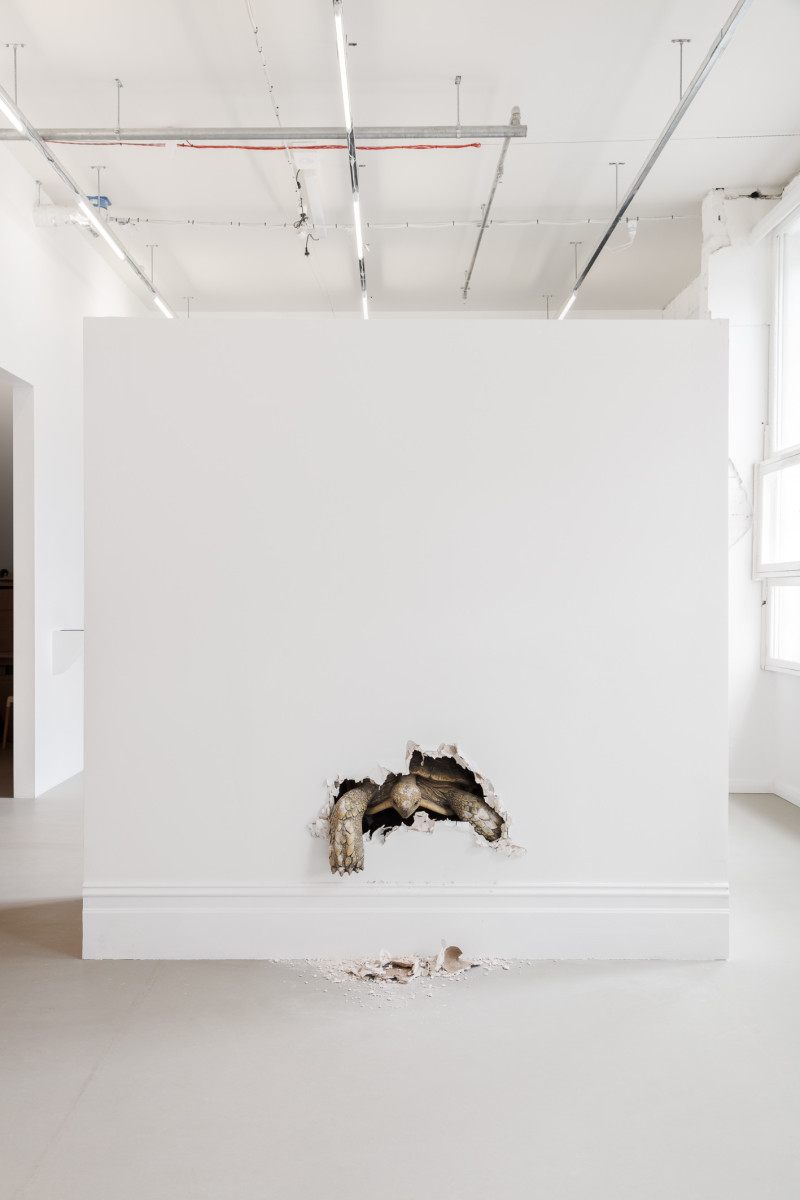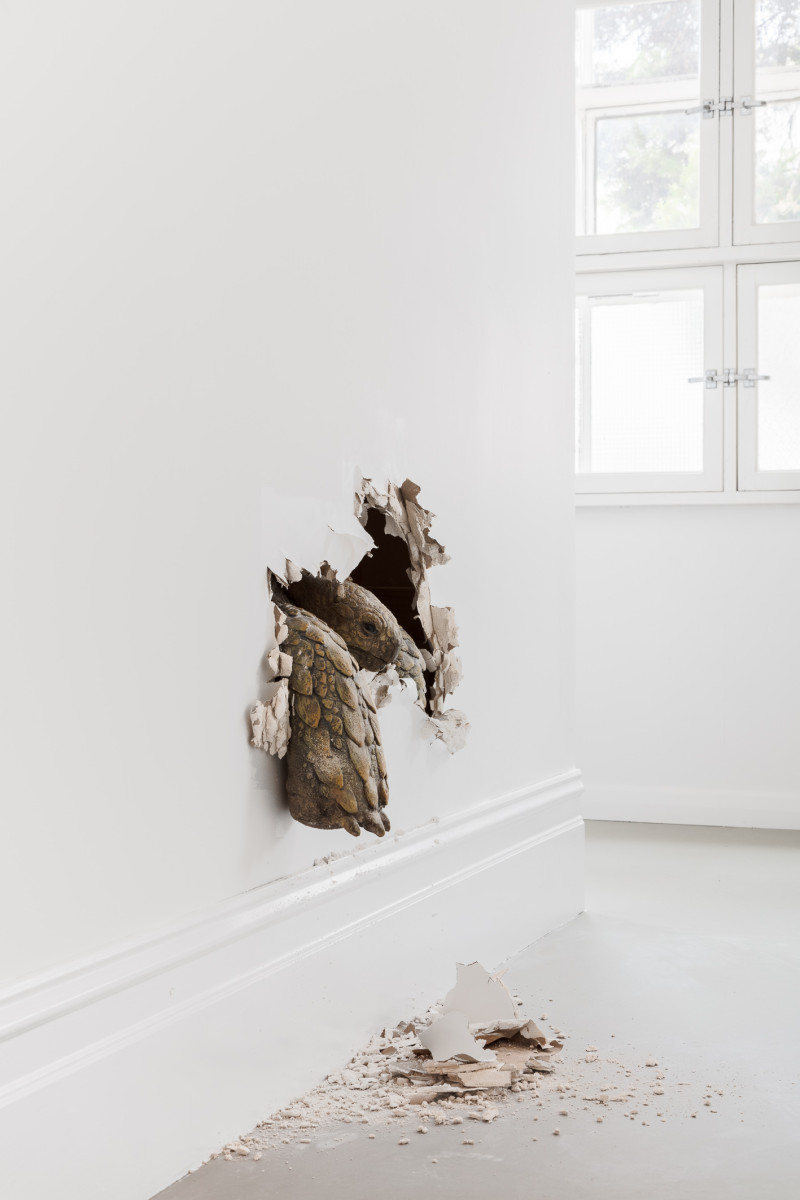Exhibits,
Liam Denny The Hermit
Opening: Tuesday 30th November, 6–8pm Dates: 30 November – 18 December, 2021
I can see Russia from Wales
Yesterday Island, 65.7522° N, 168.9243° W, 2042.
The grass grew in the glass box for a long time before it became apparent it was closed into itself and couldn’t go any further. It grew only on either side of the box, around the lightbulb located in its centre. Reaching the top of the roof it began to grow sideways and then back down the vertical walls to again reach the soil in the bottom of the box from which it had initially grown. This process repeated itself over and over until the grass began to harden. Although it didn’t wither, it became solid like a calcified spider you’d find in a stormwater drain. Fusing together, the grass repeated this ouroboric cycle until it had tightened into a knot-like case inside the box itself. At some point, the glass walls of the box were shattered by a hailstorm with stones so big they broke both the roof of the conservatory in which the box was housed, and the box itself. Somehow, the stones were unable to penetrate the walls formed by the grass and the lightbulb remained intact. Since the box had been assembled by the steward of the conservatory, the lightbulb had been plugged into a circuit board built into the stand on which the box stood.
A cord ran down the iron leg of the stand and was plugged into a multiboard connected to a double adapter which transferred power from a home wind turbine located on the conservatory’s roof. The conservatory’s glass ceiling had been shattered due to the hailstorm, and although the harsh winter weather (-15, the coldest recorded winter since 1905) entered the building through the numerous holes in its structure, the interior temperature nevertheless sat at a temperature of 25 degrees. Usually in the evening, the lightbulb was the only light source in the building once the generator that powered the house had been switched off and the conservatory steward and weather station attendant had gone to bed. Tonight was no exception, and although the wind howled viciously through the holes in the glass, the lightbulb glowed brightly, its yellow light casting shadows of its grass cage onto both the walls of the building and foliage surrounding the box itself. A few weeks later and the protective layer of grass around the bulb was now rock hard. Its fibres had separated into
small sinewy twine-like lengths and the general substance had turned at least somewhat solid. There were clearly two parts of the material that had developed, the main part of it was now hard and somewhat smooth, its surface dull and cold. The conservatory steward observed that the material had high compressive strength (10,000 psig) but was lacking in tensile strength ( >3,000 psig). This however, was offset by the reinforcement provided by the fibres in the material which formed the second part of the aspect of it, the aggregate. This allowed for it to be able to withstand stresses on a horizontal plane as well as physically direct impact. The steward, who had not seen this material before, but was familiar with the unpredictability of things in the conservatory, watched intently, waiting patiently for any sign of change in the material.
The only permanent residents on Yesterday Island were the steward and the weather station attendant. In absence of any sort of local judicial system, the island was subject to the provisional government located on the mainland (65.6092° N, 168.0875° W). The governor had declared a state of emergency, ordering the two to return to the mainland at once, in anticipation of a violent acid storm which would likely render the island uninhabitable for its duration. The weather station attendant of course, knew of the storm, and had interpreted the data differently, but the orders had come from the top and must be obeyed. The pair would be housed in the local city hall on the mainland for the duration of the storm and would return to their usual posts after it had concluded.
Back on the island after the storm and the situation was in disarray. The house was riddled with holes, its wooden cladding charred with acid burns, scarring the woodgrain with a surreal, haptic likeness. The weather station had faired better, and remained mostly intact, although had developed a layer of bright orange rust over the surface of its metal components. There was strangely, no sign whatsoever of the conservatory aside from a large pile of sand on the grass where it had been. Most of the plants that had been housed in the glass structure had also withered, and what remained was a brown/yellow/green mess of roots, leaves, petrified branches and burnt flowers. A smattering of rotting fruit fallen from a Chilean Wine Palm lay on the ground, its foul odour filling the air. The weather station attendant, clearly unhappy at the disparity of his predictions in relation to the immediate reality, threw his arms in the air, rambling about magnetic interference from crystals in the cliffs and time travel from Tomorrow Island (only 3km yet 21 hours away). The steward, however, was not paying attention and had her eyes fixed on the remains of the conservatory. Amongst the rubble, she had come to notice, remained the grass shell, its lightbulb glowing inside, as could be seen through the tiny holes in the surface of the material. The glass box, the metal stand, and the conservatory itself, had been destroyed in the acid storm yet somehow the grass shell and the lightbulb had come out untouched. Stranger yet, the lightbulb still glowed despite no longer having a connection to power of any kind. Clouds scudding across the Bering Strait, the steward looked on in quiet wonderment. As the sun began to set, the pair decided to spend the evening in the dilapidated hut, their former home, for one last night before returning to the mainland.
At around 04:52am, the steward awoke to the sun already rising. Summer was approaching and the days started early. Sunlight shot through the holes in the wooden walls of the now collapsing house. She drank some coffee with the weather station attendant in the cold morning sunshine before preparing to return to the mainland. Before leaving, the steward decided to look at the grass shell in the rubble once more. Immediately, she noticed that the shell was no longer closed on all four sides and in fact, there was something protruding from the top. A long mass of intertwined, rope- like lengths of organic material, hard like it had been before, but this time shaped in a giant spiral, binding together to create a giant column. At the base of this, there, large fan like leaves relaxed outwards, constructed from the same material. The column resembled a ship’s mast, if a ship had been made from a strange material, halfway between leaves and concrete. In the crow’s nest of the mast was the lightbulb, shining brighter than ever. It had doubled in size since the steward had last laid eyes on it. It was now 07:13am and the sunshine reflected off the bulb, casting orbs of bright white light against the deep blue, clear sky. The coils in the bulb burnt with intensity, almost as if they were smiling, leaving a feeling of peacefulness, or happy melancholy hanging in the air. You’d struggle to describe the feeling really, but it was some sort of recognition, communication beyond words. The navy picked them up, on a special request from the governor. On the trip home the weather station attendant spoke of white horses in the waves and a civilisation of turtles far to the west. The steward wasn’t listening though, her mind elsewhere as she realised the lightbulb had explained something to her that no words had yet been able to.
Jasper Jordan-Lang.
Liam Denny is a Melbourne based artist. He graduated with a Bachelor of Fine Arts at the Victorian College of the Arts in 2017 and a Fine Arts (Honours) also at the Victorian College of the Arts in 2018. Recent solo exhibitions include; Grimace, Firstdraft, Sydney, 2020; A Taste of Sweden, IRENE ROSE, Melbourne, 2018 and Bung Eye, Seventh gallery, Melbourne, 2017. Recent group exhibitions include; All worlds are flat, BLINDSIDE, Melbourne; Crushed Bone / Wet Rock, COMA gallery, Sydney; Leave the key under the mat, Bus Projects, Melbourne, 2018.

